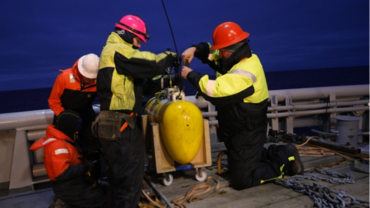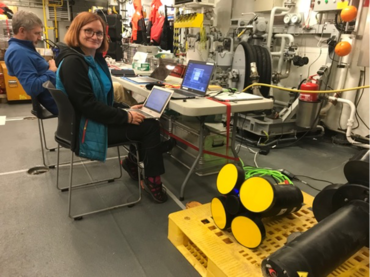
Once again, the ice breaker KV Svalbard set course for the Arctic Ocean. Onboard were NERSC researchers Hanne Sagen and Espen Storheim who planned to retrieve equipment from the CAATEX-project to prevent data loss. This mission was planned at short notice – exceptional circumstances made it necessary.
Scientists from Nansen Environmental and Remote Sensing Center (NERSC), Scripps Institution of Oceanography (SIO), Woods Hole Oceanographic Institution (WHOI), Institute of Oceanology Polish Academy of Sciences (IOPAN) and Norwegian Meteorological Institute (METNO) took part in a 5-week long expedition with the coast guard ship KV Svalbard into the Arctic Ocean. The main mission was to recover three moorings in the Beaufort Sea North of Alaska that carry acoustic and oceanographic instruments. The instruments in the moorings bring important measurements to observe the ocean climate change. The moorings are part of a trans-Arctic observing system measuring the mean ocean temperature across the whole Arctic Basin using acoustic thermometry. The new observations will be compared to similar measurements made in the 1990s. This was a unique opportunity to quantify how much the ocean under the ice has warmed during the last 20 years.
Sound propagates faster in warm water than in cold water. The acoustic thermometry concept builds on measuring how fast the sound signals propagate. These measurements require accurate time keeping. During the experiment one clock is running continuously. This clock is not as accurate as needed, and a very accurate atomic clock is turned on once a day to provide accurate times to correct the less accurate clock. The atomic clock draws a lot of energy and was due to run out of fuel this winter. If the clock stopped, it would not be possible to do the clock corrections properly, and the accuracy of the measurements would be severely reduced. To rescue these important measurements, it was urgent to recover the moorings before the batteries of the atomic clock ran dry. This was the mission of the ongoing scientific expedition to the Beaufort Sea.
So why was this recovery not carried out earlier this summer? Well, the plan was to recover the moorings in September with USCG Healy. However, due to a fire in one of the engines, just after the ice breaker left the harbour in Alaska, the expedition was cancelled. As soon as the situation occurred a request for assistance was sent from NERSC to the Norwegian Coast Guard. Based on a risk assessment the Coast Guard decided to help the CAATEX project to get back their moorings in the Beaufort Sea using their ice breaker KV Svalbard.

Agnieszka Beszczynska-Möller (IOPAN/INTAROS) downloading ocean data from the instruments in her mooring recovered North of Svalbard. Matthew Dzieciuch from SIO sitting in the background. Photo: Hanne Sagen, NERSC.
KV Svalbard and the Norwegian coast guard had previously supported the CAATEX project in 2019 and 2020 respectively, to deploy and recover similar moorings in the Nansen Basin. So, the KV Svalbard made its way to the mooring locations in the Beaufort Sea, with an experienced ship crew and team of researchers on board who knew the operations well, but they were also prepared for challenges during transit and during the operations caused by darkness and fast-growing ice. The success of the expedition depended on routinely up-dated sea ice information, including ice charts, satellite images and forecast models. That data is gathered from different providers in Norway, USA and Russia and collated and delivered to the ship by METNO in files suitable for the limited bandwidth available on the ship.
During the transit the researchers and crew onboard worked on other projects. The oceanographic mooring operated by IOPAN in the southwestern Nansen Basin was successfully recovered on October 24th from the Norwegian Coast Guard KV Svalbard. The mooring was deployed in 2019 as part of the INTAROS project. Year-long measurements of ocean temperature, salinity and currents covering the entire water column were collected to study the variability of the Atlantic inflow to the Arctic Ocean.
In support of the International Arctic Buoy Program (IABP) and the Global Drifter Program (NOAA), ten surface drifting buoys and two ice buoys were be deployed during the cruise. The buoys measure sea surface temperature, atmospheric pressure and their position for estimation of the near surface ocean currents. The data are delivered in real time and used by scientific community active in forecasting systems. In addition, in-situ sea ice observations were be collected throughout the cruise as part of the Ice Watch program, currently run by METNO.
Submitted by - Hanne Sagen, NERSC.
08 December 2020